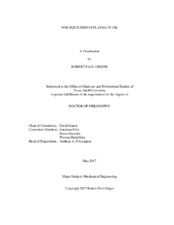| dc.description.abstract | A non-equilibrium plasma can be generated in a liquid when the energy density is controlled. The process of initiating a plasma starting with a liquid phase can be initiated by applying a sufficiently large electric potential between a pair of electrodes submerged in the liquid. An electric field propagates between the electrodes at a rate that is only limited by the speed of light. Energy is subsequently transferred from the electric field to the liquid medium in various ways. Currently, the exact physical processes that occur after an electric field is present, and just prior to electrical breakdown, are not completely understood. During this prebreakdown process, charge multiplication is occurring, reactive species are being generated, and non-equilibrium plasma is being initiated. Once breakdown occurs, charge generation and reactive species production are further accelerated, thermal energy is rapidly dissipated in the dense medium and the plasma tends toward equilibrium. This plasma initiation process will proceed as far as it can, depending on the amount of energy being provided by the external circuit. Limiting the supply of energy will therefore determine the extent to which the plasma will achieve an equilibrium state.
Non-equilibrium and non-thermal plasmas can provide some rather unique chemistry. This dissertation explores, both theoretically and experimentally, the chemistry that occurs when non-equilibrium plasma is generated in oils. To generate consistent non-equilibrium plasma, a new technique, called the Electrodynamic Ball Discharge (EBD), is devised and analyzed. This technique allows for very small energy inputs to ensure non-equilibrium plasma generation. By controlling the chemistry in this way, the oil can be cracked and upgraded rather than go through pyrolysis as would occur with the application of a thermal arc. | en |


